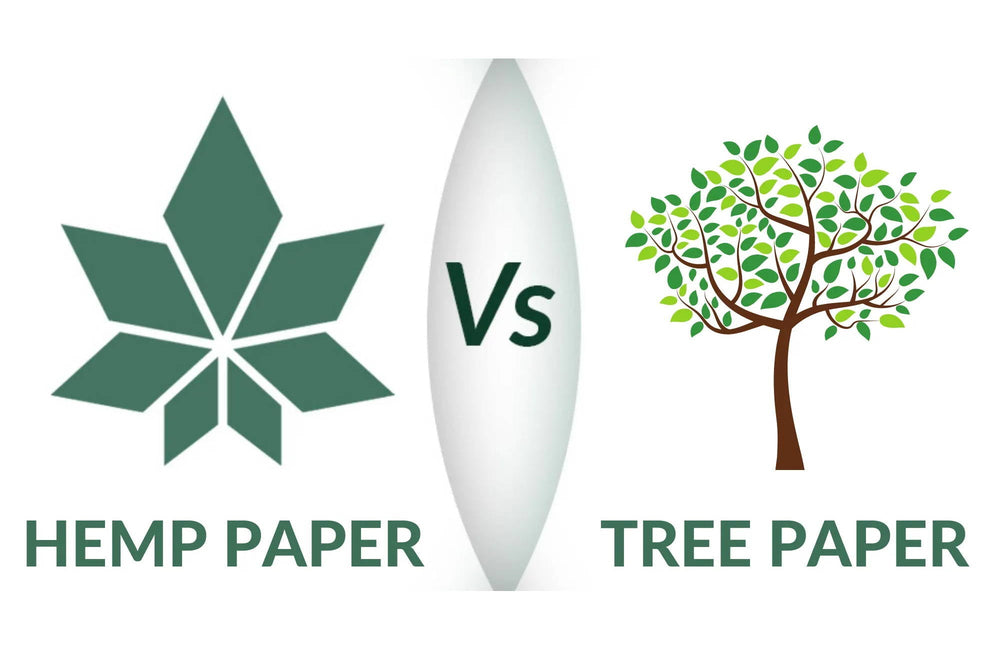
Hemp Paper vs Tree Paper: How Do They Compare?
|
If you're not happy with your first pair of underwear after trying it on, let us know.
We'll send a new size or color, or give you a refund. No returns needed.

Paulina Kwik
|
window.SHOGUN_IMAGE_ELEMENTS = window.SHOGUN_IMAGE_ELEMENTS || new Array(); window.SHOGUN_IMAGE_ELEMENTS.push({ hoverImage: '', uuid: 's-b3d18cb7-5e39-458c-8577-3827d65cd753' })
If you’re like me, you may never have considered the advantages of hemp paper vs tree paper, even if you’re already the biggest fan of sustainable underwear made with hemp or other hemp products. While the benefits of hemp vs cotton are becoming more well-known, the benefits of hemp paper products aren’t yet common knowledge. Well… they should be!
Surprisingly, choosing hemp paper vs tree paper doesn’t require a new invention. It’s a return to how paper used to be made. Ever heard of the Gutenberg Bible, Tom Sawyer, The Three Musketeers, Les Misérables, Alice in Wonderland… they were all originally written on hemp paper!
Right now, the vast majority of the world’s paper is made from trees, and I wouldn’t blame you if you took this for granted and assumed trees were the best choice for paper making. I know I did. It’s been that way our whole lives! What I didn’t realize was how unsustainable and chemically-intensive the process of making paper from trees is. Fortunately, for environmentally-friendliness, hemp paper offers us a far better option.
WHAT IS HEMP PAPER?
window.SHOGUN_IMAGE_ELEMENTS = window.SHOGUN_IMAGE_ELEMENTS || new Array(); window.SHOGUN_IMAGE_ELEMENTS.push({ hoverImage: '', uuid: 's-a6582f5b-a8b9-4c42-bab3-3e6ccc542580' })
While most conventional paper is made out of trees, hemp paper is made from the long bast fibers or short bast fibers (hurd) of the hemp plant. You may be wondering how the same plant that’s used to make super soft and comfy mens boxer briefs could possibly be used to make paper?? I did too!
The process of making hemp paper is pretty simple and similar to tree paper manufacturing. It involves breaking down hemp fibers into a pulp that can then be laid out and molded into a screen paper-making frame and dried. However, it also differs in a few very significant ways. While tree paper has a huge negative environmental impact, hemp paper and the way it’s produced reveals why it’s a better choice for those who want to care for the earth—and have their paper products last!
HEMP PAPER VS TREE PAPER: 7 REASONS HEMP IS A BETTER CHOICE
window.SHOGUN_IMAGE_ELEMENTS = window.SHOGUN_IMAGE_ELEMENTS || new Array(); window.SHOGUN_IMAGE_ELEMENTS.push({ hoverImage: '', uuid: 's-070d127e-4ab2-4451-8184-51c45a38faaf' })
1. HEMP PAPER LEADS TO LESS DEFORESTATION THAN TREE PAPER
When comparing hemp paper vs tree paper, four times more hemp paper can be produced on the same amount of land. One reason why is that hemp plants can be harvested after only four months, whereas hardwood trees take 8 to 12 years to cultivate, and softwoods take 20 to 80 years.
Not only does the time-saving characteristic of hemp mean that more paper can be produced at a faster rate to meet increasing global paper demands, but the higher yield means hemp paper production requires significantly less land, so fewer forests and natural lands need to be cleared for paper production. While clear-cutting forests leads to the destruction of indigenous habitats and is a major factor in biodiversity loss, hemp has been proven to be a biodiversity-friendly crop. Variety is the spice of life, people!
With the pulp and paper industry accounting for 40% of global industrial wood trade, it’s essential for paper production to become more sustainable for the sake of our forests, the species that make their homes in them, and the health of our planet. Hemp paper is a great choice to do just that!
window.SHOGUN_IMAGE_ELEMENTS = window.SHOGUN_IMAGE_ELEMENTS || new Array(); window.SHOGUN_IMAGE_ELEMENTS.push({ hoverImage: '', uuid: 's-ada7f068-f6dd-422f-9c6e-84ac5a6acab5' })
2. HEMP PAPER CAN BE RECYCLED MORE THAN TREE PAPER
When it comes to recyclability, hemp paper is the clear winner over tree paper. Hemp paper can be recycled more than twice as much as tree paper. Hemp paper can be recycled seven times, while tree paper can only be recycled three times. Wowzers. This is a huge difference!
Considering that non-recycled tree paper comes from virgin trees and is a major cause of deforestation, this is obviously a pretty big deal. But it’s not just that. Using more recycled paper comes with loads of other benefits:
window.SHOGUN_IMAGE_ELEMENTS = window.SHOGUN_IMAGE_ELEMENTS || new Array(); window.SHOGUN_IMAGE_ELEMENTS.push({ hoverImage: '', uuid: 's-b6389df3-a7b6-4958-bdac-77026624999d' })
3. HEMP PAPER REQUIRES FEWER CHEMICALS THAN TREE PAPER
Hemp paper production uses far less chemical processing than tree paper production. That’s partly because hemp paper can be processed and bleached with environmentally friendly and non-toxic methods like oxygen delignification and autohydrolysis. These methods use more natural compounds like sodium carbonate, and non-chemical processes using high pressure, temperatures, and steam.
But this is also true because tree pulp contains less cellulose but more lignin than hemp pulp. Cellulose is needed to provide paper’s structure. Hemp contains 55% to 77% or more cellulose while trees contain only 40% to 45% cellulose. Hemp contains only 5% to 24% lignin, but trees contain 18% to 35 % lignin. Lignin must be removed to make the paper white.
It’s this removal of tree lignin that requires more hazardous chemical processes. The fact that making hemp paper requires fewer chemicals benefits the environment, workers, and people who live near paper mills. It also doesn’t require bleach and doesn’t contaminate water like the chlorine and dioxin used by paper mills. Another win for hemp paper!
window.SHOGUN_IMAGE_ELEMENTS = window.SHOGUN_IMAGE_ELEMENTS || new Array(); window.SHOGUN_IMAGE_ELEMENTS.push({ hoverImage: '', uuid: 's-20eac617-2398-48f9-9cd8-bffe92b0ab92' })
4. HEMP PAPER LASTS LONGER THAN TREE PAPER
Because of its pure, long, and strong cellulose fibers, hemp paper is known to be chemically and mechanically stable, so it’s long-lasting. On the other hand, tree paper ends up in poor shape more quickly because of its short fibers and acidic characteristics. Tree paper is also more susceptible to environmental factors like sunlight, heat, and dampness, which can turn the paper yellow and brittle.
If you’ve ever handled a book that is more than a couple of decades old, you probably noticed that the pages have darkened and now rip easily. Books made from paper over 100 years old are rare and extremely fragile, making them difficult to still read. But rag paper (papers made of materials like hemp, cotton, and flax fibers) from the 1500s are still strong, stable in color, and flexible.
When comparing hemp paper vs tree paper it’s not just about how it’s made, it’s about how it lasts. Hemp produces an extremely durable paper. Its chemical and mechanical stability makes it a great option for printed items that are meant to last a while, like books, archival papers, and religious or sacred texts. Or writing you want to be sure to keep, like a letter to your future child or the top 40 reasons you’re glad you dumped that terrible boyfriend (for the last time)!
window.SHOGUN_IMAGE_ELEMENTS = window.SHOGUN_IMAGE_ELEMENTS || new Array(); window.SHOGUN_IMAGE_ELEMENTS.push({ hoverImage: '', uuid: 's-d8b55c14-98c3-44ce-bfff-20693e784865' })
5. THE PRODUCTION OF HEMP PAPER ABSORBS MORE CARBON DIOXIDE THAN TREE PAPER
The production of hemp paper absorbs more carbon dioxide than tree paper because hemp plants absorb more carbon dioxide than trees grown for paper do. In fact, hemp has been scientifically proven to absorb more CO2 than any forest or industrial crop. So not only does growing hemp for paper fight deforestation by minimizing the clear-cutting of forests (as mentioned in #1 above), it also helps reduce the impact of climate change by acting as the ideal carbon sink. That’s called a win-win situation in my book!
When trees are grown to be used for paper, forest clear-cutting damages the soil, and even if new seeds are planted right away, the soil disturbance leads to slower growth rates. But, after hemp is cultivated, the soil is left in optimal growing condition so that new hemp crops can be planted and grown right away just as successfully. And they keep absorbing more carbon dioxide! It’s like having a delicious loaf of bread and the perfect sourdough starter leftover instead of just some stale loaf from the grocery store.
window.SHOGUN_IMAGE_ELEMENTS = window.SHOGUN_IMAGE_ELEMENTS || new Array(); window.SHOGUN_IMAGE_ELEMENTS.push({ hoverImage: '', uuid: 's-7370dab0-5890-450a-9cb2-1da6627debdc' })
6.HEMP PAPER IS BETTER SUITED TO PERSONAL HYGIENE PRODUCTS THAN TREE PAPER
Hemp’s high tear and wet strength, water absorption ability, and antibacterial properties make it a perfect replacement for tree paper hygiene products.
These qualities mean that hemp is a great material to be used for items like hemp toilet paper, paper towels, tissues, tampons, diapers, and more. Another bonus is that unlike tree-paper products that can sometimes feel rough or scratchy (hello, cheap toilet paper) hemp hygiene products are made with soft bast fibers, so even though they are strong and durable, they’re still soft on your skin—just like a hemp bra!
Why miss out on the opportunity to pamper yourself and old mother earth at the same time with some soft and strong hemp paper personal hygiene products?
window.SHOGUN_IMAGE_ELEMENTS = window.SHOGUN_IMAGE_ELEMENTS || new Array(); window.SHOGUN_IMAGE_ELEMENTS.push({ hoverImage: '', uuid: 's-6b812176-573f-4420-8edf-4efb597ab58e' })
7.HEMP PAPER OFFERS BETTER FILTER EFFICIENCY THAN TREE PAPER
Whether you prefer your cup filled with tea or coffee, a hemp paper filter can make your beverage better than a tree paper filter. With its composition, porosity, and resistance to water, hemp has a high filter efficiency compared to other filter materials. These properties make it an effective, sustainable alternative for all types of filters besides those for coffee and tea, including oil and air filters.
The type of filter you use for these applications matters. For instance, 30% of overall coffee emissions result from the preparation method. Single-use tree paper coffee filters that are thrown out after every use contributes to deforestation and the release of toxic chemicals in landfills. But due to hemp filters’ natural antibacterial properties and strength, they can be reused.
When it comes to tea bags, tree paper is so ineffective that most tea bags must also contain some plastic to keep them together. At high temperatures, during a typical steeping process, these microplastics from tea bags can then be released into your cup of tea (and then ingested, ugh). Hemp tea bags don’t require plastic to maintain their structure. I don’t know about you, but I’d much prefer plastic-free tea!
CONCLUSION: HEMP VS. TREE PAPER
Now if someone asks, “What is hemp paper?” you’ll be able to tell them. And when it comes to hemp paper vs tree paper you know who the clear winner is. But you’re probably as surprised as I was that hemp paper isn’t more common today. Especially when it used to be! The first hemp paper was made over 2,000 years ago, and before the end of the 19th century, 75% to 90% of worldwide paper production used to be hemp!
The passing of the Marihuana Tax Act of 1937 really put an end to hemp paper production in the US. Fortunately, the 2018 farm bill has renewed the hope that hemp paper and other hemp products can now increase again. That’s good news because it’s obvious that hemp paper is more durable and longer-lasting, and it’s made in less time, on less land, and with far more sustainable and non-toxic practices.
Are you currently using any hemp paper products? If not, which hemp paper products are you most excited to try first? Share in the comments!
window.SHOGUN_IMAGE_ELEMENTS = window.SHOGUN_IMAGE_ELEMENTS || new Array(); window.SHOGUN_IMAGE_ELEMENTS.push({ hoverImage: '', uuid: 's-c074cc37-c599-4e86-a2b3-320f3ca51c76' })
Get updates on restocks, new color and size releases, and upcoming product launches. You’ll also get a 15% discount on your first order of hemp underwear.


